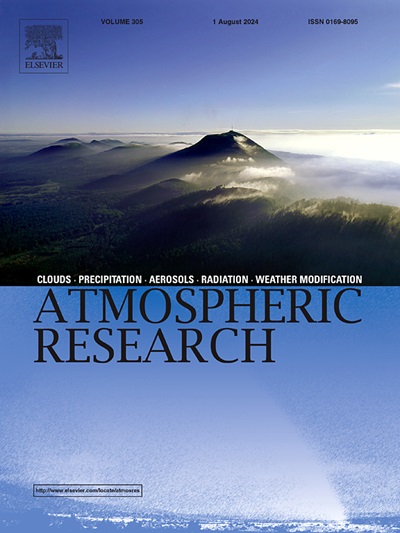全球陆地复合干热事件区可探测的人为扩展
IF 4.4
2区 地球科学
Q1 METEOROLOGY & ATMOSPHERIC SCIENCES
引用次数: 0
摘要
在全球变暖背景下,人为影响导致全球复合干热事件(CDHEs)发生频率增加。然而,人类活动对温室气体排放影响的空间范围研究有限。我们的分析侧重于1961 - 2013年暖季期间全球陆地CDHEs受影响面积的变化,结果表明,在半球和六大洲都有增加的趋势,其中北半球(15.8% /53年)、亚洲(16% /53年)和非洲(14% /53年)的增加最为明显。利用最优指纹识别方法进行检测和归因分析,发现除大洋洲外,其他地区均能检测到人为活动信号。温室气体排放在除大洋洲外所有区域观测到的增加趋势中发挥了主要作用。此外,我们对北半球类似2022年的CDHEs区域进行了事件归因分析,发现北半球、亚洲和欧洲分别有近95%、91%和89%的趋势可归因于人为气候变化。利用归因结果,对SSP2-4.5和SSP5-8.5排放情景下CDHEs的空间范围进行了约束预估。与原始预估(亚洲除外)相比,约束预估的增幅较小,在南半球的南美洲观测到的差异最大。预计到2100年,在SSP2-4.5和SSP5-8.5情景下,北半球的CDHEs面积将分别达到43%和68%。亚洲面临的chde影响最为广泛,超过93%的人处于SSP5-8.5情景下,56%的人处于SSP2-4.5情景下。因此,减少温室气体排放对于更好地减轻CDHEs对全球土地的影响具有巨大的好处。本文章由计算机程序翻译,如有差异,请以英文原文为准。
Detectable Anthropogenic Expansion of Compound Dry and Hot Event Areas on Global Land
Anthropogenic influence have led to an increase in the frequency of compound dry and hot events (CDHEs) globally under the background of global warming. However, there is limited research on the extent of anthropogenic influence on the spatial extent of CDHEs. Our analysis, focusing on the changes in the affected area of CDHEs across the global land during the warm season from 1961 to 2013, indicates an increasing trend in both hemispheres and six continents, with the most obviously increases observed in the Northern Hemisphere (15.8 %/53 yr), Asia (16 %/53 yr), and Africa (14 %/53 yr). Using the optimal fingerprinting method for detection and attribution analysis, we found that the anthropogenic signal was robustly detected in all regions except Oceania. The greenhouse gases emission played a major role in the observed increasing trends in all regions except Oceania. Furthermore, we conducted an event attribution analysis for the 2022–like CDHEs areas in the Northern Hemisphere, finding that nearly 95 %, 91 %, and 89 % of the trends in the Northern Hemisphere, Asia, and Europe, respectively, could be attributed to anthropogenic climate change. Using the attribution result, we constrained projections of spatial extent of CDHEs under the SSP2–4.5 and SSP5–8.5 emission scenarios. The constrained projections show a smaller increasing magnitude compared to the raw projections (except for Asia), with the largest differences observed in South America in the Southern Hemisphere. By 2100, the CDHEs areas in the Northern Hemisphere are projected to reach 43 % and 68 % under the SSP2–4.5 and SSP5–8.5 scenarios, respectively. Asia faces the most widespread impact from CHDEs, with more than 93 % under the SSP5–8.5 scenario and 56 % under the SSP2–4.5 scenario. Therefore, reducing greenhouse gas emissions has huge benefits for better mitigating the impacts of CDHEs across the global land.
求助全文
通过发布文献求助,成功后即可免费获取论文全文。
去求助
来源期刊

Atmospheric Research
地学-气象与大气科学
CiteScore
9.40
自引率
10.90%
发文量
460
审稿时长
47 days
期刊介绍:
The journal publishes scientific papers (research papers, review articles, letters and notes) dealing with the part of the atmosphere where meteorological events occur. Attention is given to all processes extending from the earth surface to the tropopause, but special emphasis continues to be devoted to the physics of clouds, mesoscale meteorology and air pollution, i.e. atmospheric aerosols; microphysical processes; cloud dynamics and thermodynamics; numerical simulation, climatology, climate change and weather modification.
 求助内容:
求助内容: 应助结果提醒方式:
应助结果提醒方式:


